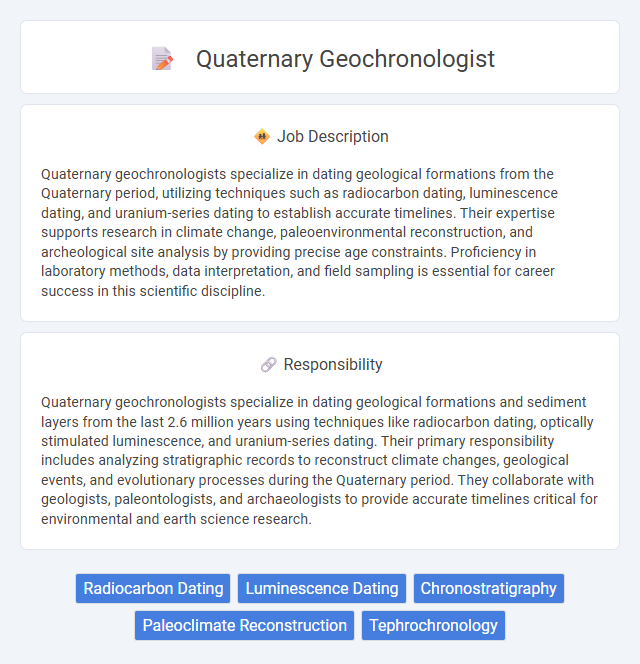
Quaternary geochronologists specialize in dating geological formations from the Quaternary period, utilizing techniques such as radiocarbon dating, luminescence dating, and uranium-series dating to establish accurate timelines. Their expertise supports research in climate change, paleoenvironmental reconstruction, and archeological site analysis by providing precise age constraints. Proficiency in laboratory methods, data interpretation, and field sampling is essential for career success in this scientific discipline.
Individuals with a strong interest in earth sciences and a detail-oriented mindset are likely suitable for a career as a Quaternary geochronologist, as the job often involves meticulous analysis of sediment layers and dating techniques. Candidates comfortable with fieldwork in varied and sometimes harsh environmental conditions may find the role more fulfilling. Those who prefer routine office settings or less scientific uncertainty might face challenges adapting to the demands of this specialized field.
Qualification
Quaternary geochronologists typically hold advanced degrees in geology, geochemistry, or Earth sciences, with specialized training in dating techniques such as radiocarbon, luminescence, or uranium-series dating. Proficiency in analytical instrumentation, data interpretation, and field sampling is essential for accurate age determinations of Quaternary sediments and fossils. Experience with laboratory methods, software for chronological modeling, and published research in peer-reviewed journals further strengthens a candidate's qualifications for this role.
Responsibility
Quaternary geochronologists specialize in dating geological formations and sediment layers from the last 2.6 million years using techniques like radiocarbon dating, optically stimulated luminescence, and uranium-series dating. Their primary responsibility includes analyzing stratigraphic records to reconstruct climate changes, geological events, and evolutionary processes during the Quaternary period. They collaborate with geologists, paleontologists, and archaeologists to provide accurate timelines critical for environmental and earth science research.
Benefit
Quaternary geochronologists likely benefit from contributing to the understanding of Earth's recent geological past, which can aid in predicting future climate changes and environmental shifts. Their expertise may offer opportunities in academia, environmental consulting, and governmental research roles, providing career stability and intellectual fulfillment. The specialized skills in dating techniques and sediment analysis could also enhance employability and professional recognition within the geoscience community.
Challenge
Quaternary geochronologists may face challenges related to the accurate dating of complex sedimentary sequences and interpreting environmental changes over intricate timescales. The probability of encountering difficulties in calibrating dating methods or dealing with degraded samples is relatively high. These challenges require specialized analytical techniques and a deep understanding of geochronological methods to produce reliable results.
Career Advancement
Quaternary geochronologists specialize in dating geological formations to understand Earth's recent history, using techniques like radiocarbon dating and luminescence. Career advancement often involves transitioning from research assistant roles to lead scientist positions in academia, environmental consulting, or government agencies. Gaining expertise in cutting-edge analytical methods and securing grant-funded projects significantly enhances prospects for senior roles and interdisciplinary collaborations.
Key Terms
Radiocarbon Dating
A Quaternary geochronologist specializing in radiocarbon dating applies carbon-14 analysis to determine the age of organic materials up to 50,000 years old, essential for reconstructing Earth's recent geological history. Expertise in calibration curves and contamination prevention enhances accuracy in dating prehistoric events, sediments, and archaeological artifacts. These specialists contribute to climate change studies, paleoecology, and evolutionary research by providing precise chronological frameworks for Quaternary period datasets.
Luminescence Dating
Quaternary geochronologists specializing in luminescence dating analyze sediment and mineral samples to determine the timing of geological events from the last 2.6 million years. Their expertise in optically stimulated luminescence (OSL) and thermoluminescence (TL) techniques enables precise age estimations of soil and archaeological deposits. This role supports climate change research, paleoenvironmental reconstruction, and archaeological chronology by providing critical data on sediment deposition and landscape evolution.
Chronostratigraphy
Quaternary geochronologists specializing in chronostratigraphy analyze sedimentary layers and fossil records to establish precise chronological frameworks for the Quaternary period, which spans the last 2.6 million years. Their expertise includes dating techniques such as radiocarbon dating, luminescence dating, and tephrochronology to correlate stratigraphic sequences with global climatic and environmental changes. Mastery in integrating geochronological data supports reconstructing Earth's recent geological history and understanding the timing of glacial and interglacial events.
Paleoclimate Reconstruction
Quaternary geochronologists specializing in paleoclimate reconstruction analyze sediment cores, ice layers, and fossil records to date events within the last 2.6 million years, providing precise timelines of climate changes. Techniques such as radiocarbon dating, luminescence dating, and uranium-thorium dating are critical for establishing chronological frameworks that link geological events to global paleoclimate trends. Their work informs models of past climate variability, aiding predictions of future climate scenarios by interpreting data from glacial-interglacial cycles and anthropogenic impacts.
Tephrochronology
Quaternary geochronologists specializing in tephrochronology analyze volcanic ash layers to establish precise dating frameworks for sedimentary sequences spanning the last 2.6 million years. They utilize geochemical fingerprinting of tephra deposits to correlate stratigraphic records across diverse geographic regions, enhancing the resolution of paleoenvironmental and archaeological studies. Expertise in methods such as electron microprobe analysis and radiometric dating underpins their ability to construct accurate chronological models critical for Quaternary research.
 kuljobs.com
kuljobs.com